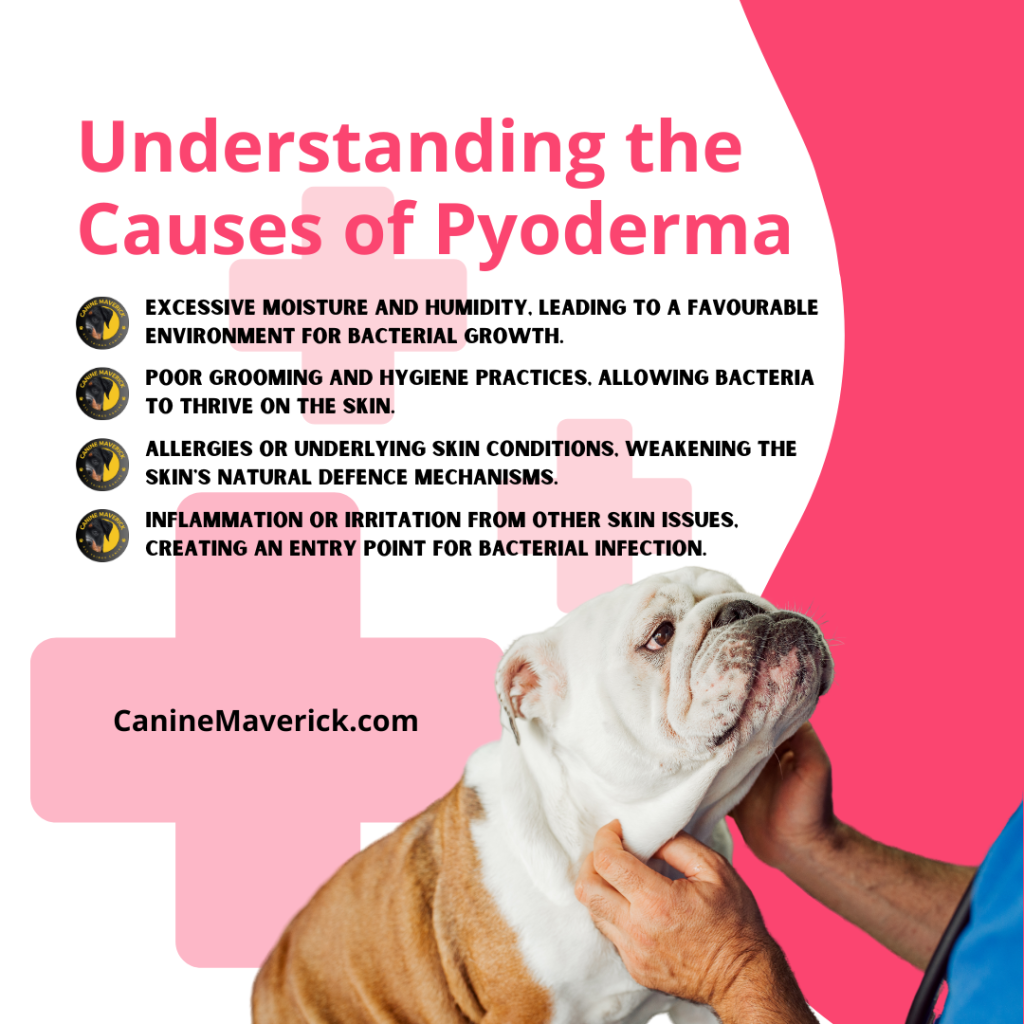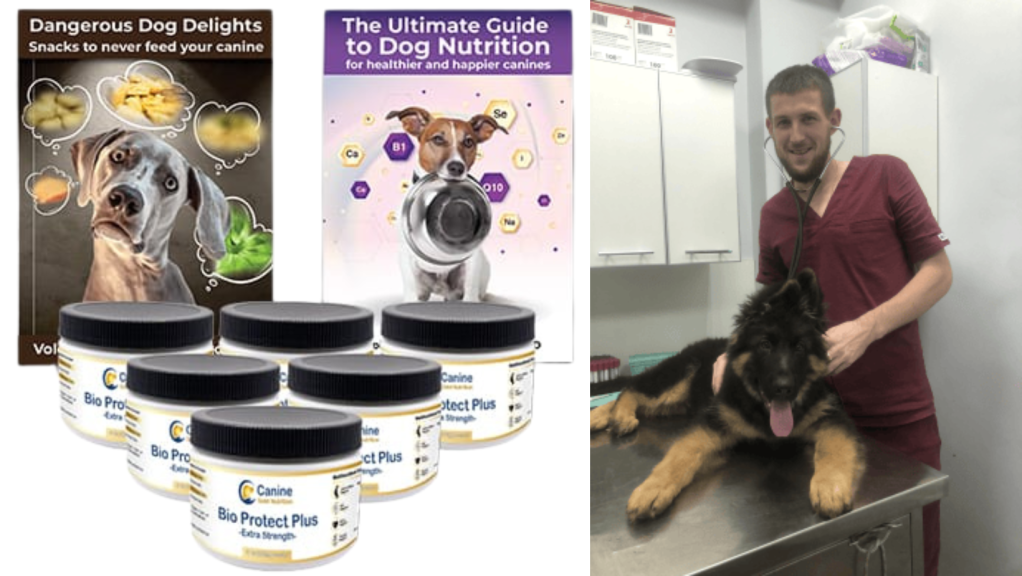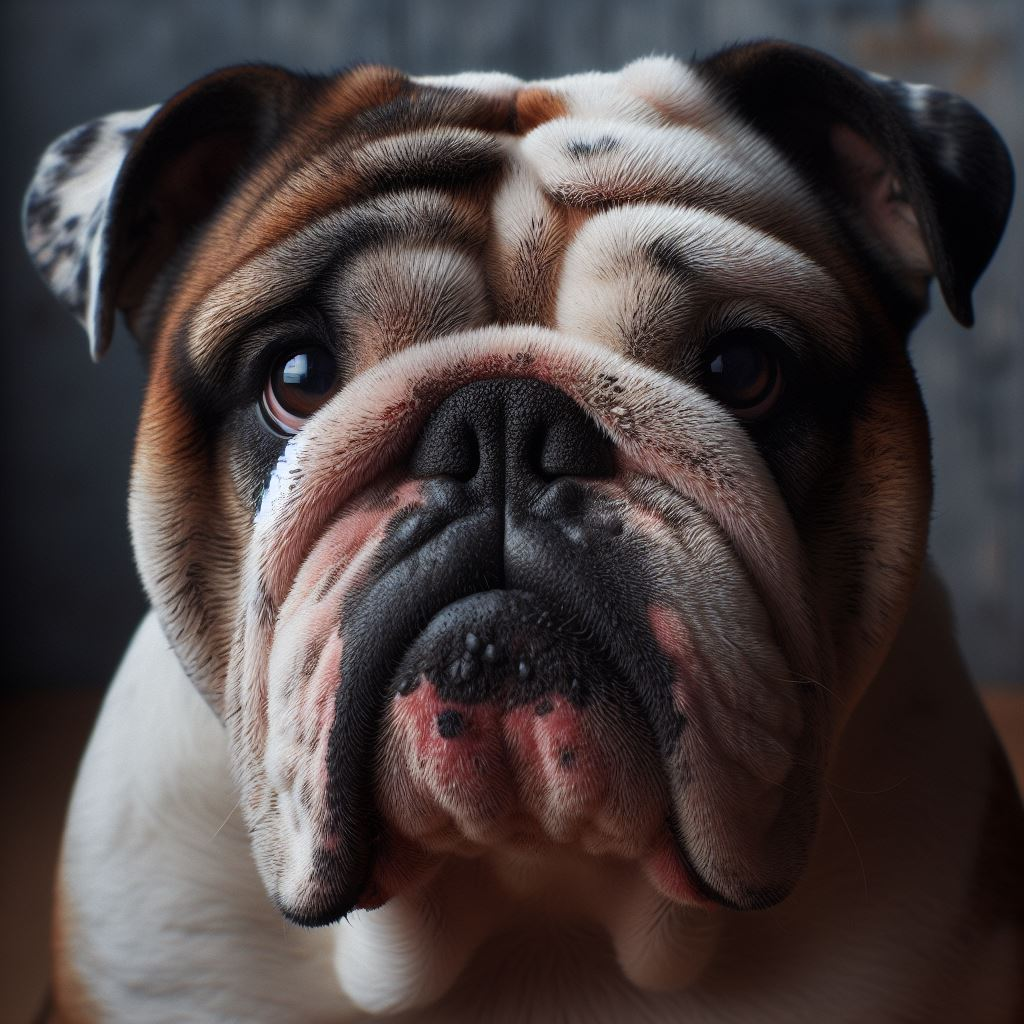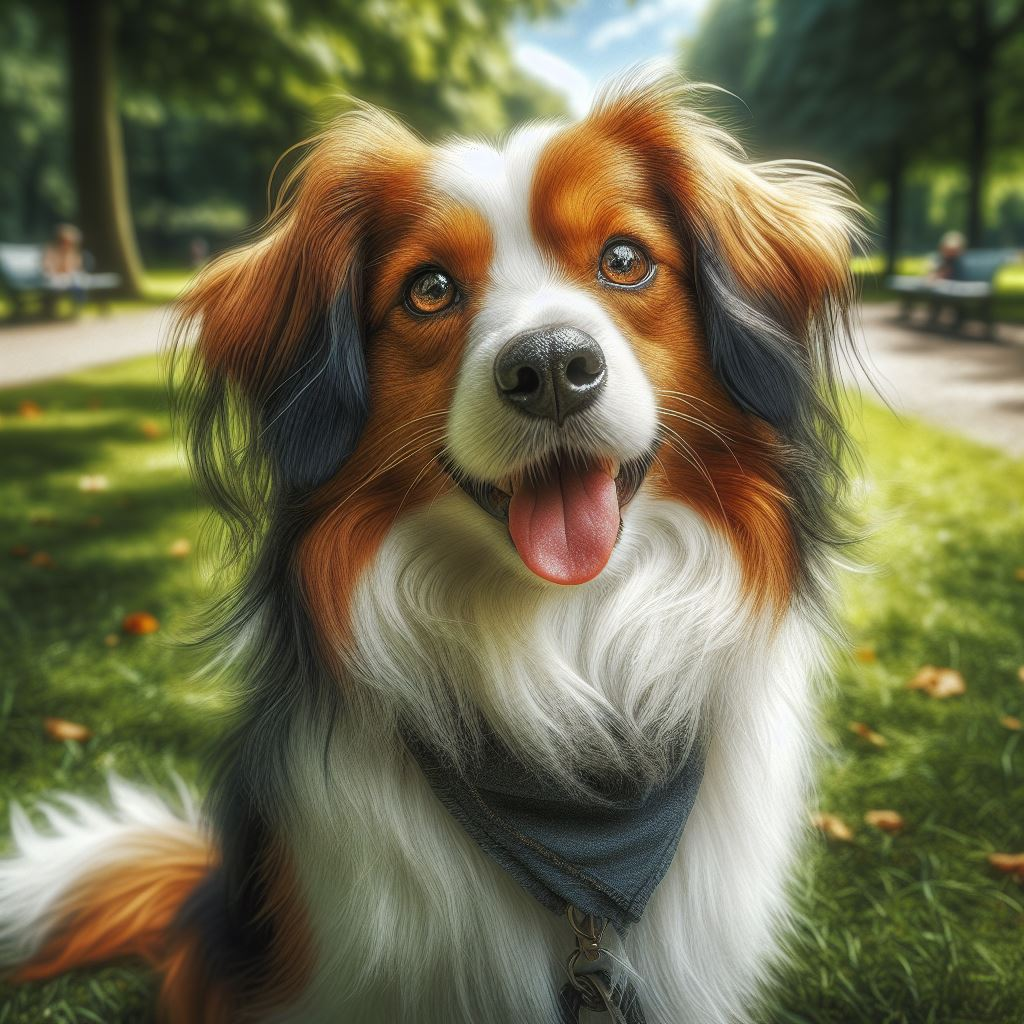Introduction
Did you know that Bulldogs (a.k.a. English Bulldogs or British Bulldogs) are more prone to skin issues than other dog breeds? In fact, English Bulldog skin problems are particularly prevalent. These adorable canines, with their wrinkled faces and folds, require special attention to maintain their skin health. In this article, I delve into the causes of bulldog skin issues and provide valuable care tips to keep your furry friend happy and comfortable.

Key Takeaways:
- Bulldogs are at a higher risk of developing skin issues compared to other dog breeds.
- English Bulldogs are particularly prone to various skin conditions and problems.
- Proper care and attention are essential for maintaining bulldog skin health.
- Understanding the causes of bulldog skin issues can help prevent and manage them.
- Stay tuned for valuable care tips to ensure your bulldog’s skin remains healthy and happy.
- Introduction
- Understanding Bulldog Skin Conditions
- Identifying Skin Issues in Bulldogs
- Bulldog Skin Issues: Diagnosis and Professional Care
- Wrinkle and Fold Dermatitis in Bulldogs
- Food Allergies and Skin Reactions
- Environmental and Contact Allergies in Bulldogs
- Addressing Interdigital Cysts in Bulldogs
- Managing Bulldog Pyoderma
- The Critical Role of Routine Skincare
- My Conclusion
- FAQ Section
- What are the causes of bulldog skin issues?
- What are the common skin issues that affect bulldogs?
- How can I identify skin issues in my bulldog?
- What are common misconceptions about bulldog skin issues?
- What is wrinkle and fold dermatitis?
- How do food allergies contribute to bulldog skin issues?
- What are common environmental triggers for bulldog allergies?
- What is the role of routine skincare in bulldog health?
- Source Links

Understanding Bulldog Skin Conditions
All Bulldogs are susceptible to several skin conditions that can cause discomfort and irritation. Understanding these skin conditions is crucial for effective management. This section will provide an overview of common skin issues that affect bulldogs and their underlying causes.
Bulldogs are prone to a variety of skin problems due to their unique genetic makeup. One common issue is atopic dermatitis, which is an allergic skin reaction to environmental triggers such as pollen, dust mites, or certain foods. Another common skin condition in bulldogs is intertrigo, also known as wrinkle and fold dermatitis, which occurs in the folds of their skin and can become inflamed and infected if not properly managed.
Bacterial infections, such as pyoderma, are also prevalent in bulldogs due to the warm and moist environment created by their skin folds. These infections can cause redness, itching, and the formation of pustules or crusts on the skin. Additionally, bulldogs are prone to contact dermatitis, which is caused by an allergic reaction to certain substances they come into contact with, such as cleaning products or certain fabrics.
It is important to note that bulldogs may also develop food allergies, which can manifest as skin issues. These allergies can be triggered by ingredients such as beef, chicken, or grains. Identifying and eliminating the allergens from their diet can help alleviate their skin problems.
By understanding the common skin conditions that affect bulldogs and their underlying causes, owners can take proactive steps to prevent and manage these issues. In the following sections, I delve deeper into how to identify and address specific skin problems in bulldogs, as well as provide tips for maintaining healthy skin through proper care and skincare routines.
Identifying Skin Issues in Bulldogs
Identifying skin conditions in English bulldogs can be a challenging task, as their skin can be prone to various problems. Therefore, it’s important for bulldog owners to be aware of the common symptoms that may indicate a skin issue.

If you notice any of these symptoms, it’s crucial to consult a veterinarian for a proper diagnosis and treatment plan.
The Importance of Early Detection
Bull dog allergies are common and early detection of skin issues in is vital for their overall well-being and comfort. By identifying and addressing skin problems at the earliest stage possible, you can prevent the issue from worsening and causing further complications. Regularly monitoring your bulldog’s skin and being proactive in seeking veterinary care can significantly improve their quality of life.
Common Misconceptions
There are several common misconceptions about bulldog skin issues that need to be debunked. Some of these misconceptions include:
- British Bulldog skin problems are only a cosmetic concern and not a serious health problem. ❌
- All bulldogs will develop skin issues, so there’s no need for preventive measures. ❌
- Only bulldogs with excessive skin folds are prone to skin problems. ❌
- Bulldog skin issues can be cured with over-the-counter products without veterinary guidance. ❌
It’s important to understand that bulldog skin issues can have both cosmetic and health implications. Additionally, all bulldogs, regardless of the extent of their skin folds, are susceptible to skin problems. Seeking professional veterinary advice and following their recommendations is crucial for managing and treating bulldog skin issues effectively.
Bulldog Skin Issues: Diagnosis and Professional Care
When you suspect a skin issue in your bulldog, it is crucial to seek professional diagnosis and care. Veterinary expertise is essential in accurately identifying the problem and determining the most effective course of action for your pet’s health and well-being.
Professional diagnosis begins with a thorough examination of your bulldog’s skin, taking into account any visible symptoms and the history of the condition. In some cases, additional tests and procedures may be required to pinpoint the exact cause of the skin issue.
Once a diagnosis has been made, a veterinarian can provide you with the necessary guidance and treatment options for your bulldog’s specific condition. This may involve topical or oral medications, specialised shampoos, or other interventions tailored to address the underlying cause of the skin issue.
Professional care for bulldog skin conditions goes beyond the initial diagnosis and treatment. Ongoing monitoring and follow-up appointments with a veterinarian are crucial to ensure that the skin issue is properly addressed and managed.
Additionally, regular check-ups can help prevent future skin issues and detect any potential problems at an early stage. Your veterinarian can provide you with valuable advice on maintaining your bulldog’s skin health and recommend suitable skincare products and grooming practices for your pet.
As a responsible bulldog owner, seeking professional care and guidance is essential to ensure the well-being and comfort of your beloved pet.
Pets Calm Down’s Stop Bloody Scratching for dogs. The product is for seasonal and other allergies. →Click the image to learn more←
Wrinkle and Fold Dermatitis in Bulldogs
Wrinkle and fold dermatitis, also known as intertrigo, is a common skin issue in bulldogs. This condition occurs due to the moisture and friction that accumulate in the folds and wrinkles of a bulldog’s skin. The constant rubbing can lead to inflammation, redness, and discomfort for your furry friend.
There are several causes of wrinkle and fold dermatitis in bulldogs. One of the main factors is the structure of their skin, which has deep folds and wrinkles that provide the perfect environment for moisture and bacteria to thrive. Additionally, poor hygiene, allergies, and obesity can exacerbate the condition.
Recognising the symptoms of wrinkle and fold dermatitis is vital for early intervention and management. Some common signs include redness, swelling, a foul odour, discharge, and skin irritation. If left untreated, the condition can progress and lead to more severe complications such as skin infections and open sores.
To prevent and manage wrinkle and fold dermatitis in your bulldog, it is essential to establish a regular skincare routine. This includes gently cleaning and drying the folds and wrinkles, ensuring they are free from moisture and debris. Regular grooming, such as trimming excessive facial hair and keeping the folds clean, can also help prevent the condition.
In cases where the dermatitis has already developed, it is important to consult a veterinarian for proper diagnosis and treatment. They may recommend medicated shampoos, topical ointments, or antibiotics to control inflammation and prevent infection. Your vet can also provide additional guidance on managing the condition at home and preventing recurrences.
By taking proactive measures and providing appropriate care, you can help alleviate the discomfort caused by wrinkle and fold dermatitis, ensuring your bulldog’s skin remains healthy and happy.
| Causes of Wrinkle and Fold Dermatitis in Bulldogs | Prevention and Management Tips |
|---|---|
| Poor Hygiene | Establish a regular skincare routine. Gently clean and dry the folds and wrinkles. Trim excessive facial hair |
| Allergies | Identify and avoid potential allergens. Consult with a veterinarian for allergy testing. Follow prescribed treatment plans |
| Obesity | Maintain a healthy weight through proper diet and exercise. Consult with a veterinarian for personalised weight management advice |

Food Allergies and Skin Reactions
Food allergies can contribute to English Bulldog skin conditions. Identifying the specific food allergens that trigger these reactions is crucial for effectively managing your bulldog’s skin health. Switching to a suitable diet that eliminates the allergens can help alleviate symptoms and improve your bulldog’s overall well-being. It’s important to monitor for improvements in your bulldog’s skin health to ensure that the new diet is effective.
Identifying Food Allergens
Identifying the specific food allergens that your bulldog reacts to can be a complex process. Your veterinarian can perform tests to pinpoint the allergens causing the skin issues. These tests may include elimination diets, blood tests, or intradermal skin tests. By identifying the allergens, you can make informed decisions about your bulldog’s diet and provide relief from skin reactions.
Switching to a Suitable Diet
Once you have identified the food allergens, it’s important to switch to a suitable diet that eliminates these allergens. Your veterinarian may recommend a prescription hypoallergenic diet or a homemade diet that excludes the specific allergens. It’s essential to follow the recommended diet strictly to avoid accidental exposure to the allergens and to allow your bulldog’s skin to heal. Making gradual changes to the diet can help ensure a smooth transition.
Monitoring for Improvement
After switching to a suitable diet, it’s important to monitor your English bulldog skin issues for improvements. Keep a close eye on any changes in the appearance of their skin, including redness, itching, or rashes. Document any improvements or changes you observe and share them with your veterinarian during follow-up appointments. Regular monitoring will help you determine if the new diet is effective in managing your bulldog’s food allergies and skin reactions.

Environmental and Contact Allergies in Bulldogs
Bulldogs are prone to environmental and contact allergies, which can have a significant impact on their skin health. These allergies are often triggered by various substances present in their surroundings. Understanding and managing these allergies is crucial to ensure the well-being of your bulldog.
Common Environmental Triggers
There are several common environmental triggers that can cause allergic reactions in bulldogs. These triggers include:
- Pollen
- Dust mites
- Mold spores
- Grass and weeds
- Household cleaning products
- Certain fabrics
Identifying and minimising your bulldog’s exposure to these triggers can help alleviate their allergy symptoms and improve their overall skin health.
Managing Your Bulldog’s Exposure
Managing your bulldog’s exposure to allergens is an essential part of controlling their environmental and contact allergies. Here are some strategies to help you effectively manage your bulldog’s exposure:
- Keep the living environment clean by regularly vacuuming and dusting.
- Limit your bulldog’s outdoor activities during peak pollen seasons.
- Use hypoallergenic bedding and avoid using harsh chemicals or fragrances in your bulldog’s living area.
- Wash your bulldog’s bedding regularly to remove any allergens.
- Consider using air purifiers or filters to reduce airborne allergens.
- Consult with your veterinarian to determine if specific environmental allergen testing or immunotherapy is necessary for your bulldog.
Treatment Options for Allergies
When it comes to treating environmental and contact allergies in bulldogs, there are various options available. These may include:
- Antihistamines: These medications can help reduce the itching and inflammation caused by allergies.
- Corticosteroids: In more severe cases, corticosteroids may be prescribed to alleviate allergic reactions.
- Immunotherapy: Allergen-specific immunotherapy, such as allergy shots or sublingual drops, may be recommended in certain cases to desensitise the bulldog’s immune system to the allergens over time.
- Topical treatments: Topical creams or ointments can provide relief from skin irritation and help soothe allergic reactions.
It’s important to consult with your veterinarian to determine the most suitable treatment options for your bulldog’s allergies. They will be able to assess your bulldog’s specific needs and develop a personalised treatment plan.
Addressing Interdigital Cysts in Bulldogs
Interdigital cysts can be a common and bothersome skin condition in bulldogs. These cysts, also known as interdigital furuncles, are painful, inflamed swellings that usually occur between the toes of your bulldog. They can cause discomfort, lameness, and even difficulty walking. It’s important to address interdigital cysts promptly to alleviate your bulldog’s discomfort and prevent further complications.
Treatment for interdigital cysts in bulldogs may vary depending on the severity of the condition. In mild cases, your veterinarian may recommend soaking your bulldog’s paws in an antiseptic solution or an Epsom salt bath. This can help reduce inflammation and keep the area clean. Your vet may also prescribe topical treatments, such as medicated sprays or ointments, to address the cysts.
In more severe cases, your veterinarian may need to drain the cysts or perform surgery to remove them. This is usually done under anaesthesia to minimise pain and discomfort for your bulldog. Your vet may also prescribe oral antibiotics to treat any underlying infections.
Preventing interdigital cysts in bulldogs involves proper grooming and hygiene. Regularly inspect your bulldog’s paws for any signs of irritation or swelling. Keep the paws clean and dry, as moisture can contribute to the development of cysts. Trim the hair between the toes to prevent matting and excessive moisture retention. It’s also important to avoid walking your bulldog on abrasive surfaces that can irritate the paws.
Regular veterinary check-ups can also help in the early detection and prevention of interdigital cysts. Your veterinarian will be able to assess your bulldog’s overall paw health and provide guidance on proper grooming techniques and preventive measures.
Managing Bulldog Pyoderma
Pyoderma, a bacterial skin infection, can be a concern for bulldogs. It is important to understand the causes of pyoderma in bulldogs and implement effective treatment strategies. Additionally, taking preventive measures can minimise the risk of pyoderma in bulldogs.
Understanding the Causes
Pyoderma in bulldogs can be caused by various factors… see the image below:

Identifying the underlying cause of pyoderma is essential for effective management and prevention.
Effective Treatment Strategies
Treating bulldog pyoderma typically involves a combination of topical and systemic treatments. The specific treatment plan may vary depending on the severity of the infection and the veterinarian’s recommendations. Common treatment strategies include:
- Antibiotic therapy: The use of antibiotics to eliminate the bacterial infection.
- Topical antiseptic solutions: Applying antiseptic solutions to disinfect the affected areas.
- Cleaning and drying: Regularly cleaning the affected areas and ensuring they are thoroughly dried to prevent bacterial growth.
- Regular bathing: Using medicated shampoos or prescribed cleansing products to maintain proper hygiene.
- Dietary adjustments: In some cases, dietary changes may be recommended to support immune function and overall skin health.
Prevention Tips for Pyoderma
Preventing pyoderma in bulldogs involves proactive measures to minimise the risk of bacterial skin infections. Consider the following prevention tips:
- Maintain a regular grooming routine, paying special attention to cleaning the skin folds and wrinkles.
- Keep your bulldog’s skin dry and free from excessive moisture.
- Ensure proper nutrition and a balanced diet to support a healthy immune system.
- Identify and address any underlying allergies or skin conditions promptly.
- Avoid exposing your bulldog to known irritants or allergens that could compromise their skin health.
- Regularly inspect your bulldog’s skin for any signs of irritation, redness, or infection.
By implementing these prevention tips, you can significantly reduce the likelihood of your bulldog developing pyoderma.

It is your pet’s turn to SHINE!
We are in Birmingham City Centre
The Critical Role of Routine Skincare
Routine skincare is vital for the overall health and well-being of your beloved bulldog. Regular care ensures that their skin remains clean, moisturised, and free from common skin issues. By establishing a daily skincare routine, choosing the right products, and following professional grooming advice, you can help your bulldog maintain healthy and happy skin.
Daily Skincare Routine
A daily skincare routine is essential for bulldogs to keep their skin in top condition. This routine should include gentle cleansing to remove dirt and excess oils, followed by moisturising to hydrate the skin. Additionally, it is important to regularly check and clean your bulldog’s skin folds to prevent any bacterial or fungal infections. By maintaining a consistent daily skincare routine, you can minimise the risk of skin problems and promote a healthier coat for your furry friend.
Choosing the Right Products
When it comes to skincare products for your bulldog, it is crucial to select those specifically formulated for their unique needs. Look for gentle, hypoallergenic cleansers and moisturisers that are free from harsh chemicals and artificial fragrances. It is also advisable to consult your veterinarian for recommendations on the best skincare products suitable for your bulldog’s skin type and any specific skin concerns they may have.
Remember to always read the labels and ingredients list to ensure that the products you choose are safe and effective. Your bulldog deserves the best care, so investing in high-quality skincare products is essential for maintaining their skin health.

Itch Stop Wipes provide fast-acting relief for the itching and pain resulting from flea bites, hot spots and skin irritations.
Contains witch hazel, aloe vera gel, comfrey and vitamins for cooling relief, plus lidocaine to stop itch and pain. Bitter taste helps stop licking, scratching and biting to prevent further irritation.
Professional Grooming Advice
While routine care at home is crucial, it is equally important to seek professional grooming advice for your bulldog. Experienced groomers can provide valuable insights and tips on maintaining your bulldog’s skin and coat health, as well as performing specialised grooming procedures such as ear cleaning and nail trimming. They can also identify any potential skin issues early on, leading to prompt intervention and treatment.
Regular visits to a professional groomer ensure that your bulldog receives comprehensive care, from proper coat maintenance to the overall health of their skin. Proper grooming practices not only enhance your bulldog’s appearance but also contribute to their well-being and overall quality of life.
Prioritising routine skincare for your bulldog is essential for maintaining their skin health. By establishing a daily skincare routine, choosing appropriate products, and seeking professional grooming advice, you can ensure that your bulldog’s skin remains healthy, clean, and free from common skin issues. By taking proactive steps and providing proper care, you can help your bulldog to live a comfortable and happy life.

My Conclusion
As any owner will know, bulldogs are prone to various skin issues that can cause discomfort and affect their overall well-being. However, with proper care and management, these issues can be effectively addressed, allowing your bulldog to live a healthy and happy life.
Throughout this article, I’ve explored the causes of bulldog skin issues and provided valuable tips for their care. I’ve discussed common skin conditions, identified symptoms to watch for, and highlighted the importance of early detection. I’ve also debunked common misconceptions and emphasised the significance of seeking professional diagnosis and care.
Additionally, I have delved into specific skin issues such as wrinkle and fold dermatitis, food allergies and skin reactions, environmental and contact allergies, interdigital cysts, and pyoderma. I’ve provided insight into the causes, treatment strategies, prevention tips, and management approaches for each condition.
It’s important to remember, establishing a routine skincare regimen, including a daily skincare routine and choosing the right products, is critical in maintaining your bulldog’s skin health. Professional grooming advice can also be invaluable in ensuring your bulldog’s skin stays in optimal condition.
By following the information and advice outlined in this article, you can proactively care for your bulldog’s skin, minimising the risk of skin issues and promoting their overall well-being. Remember, a happy and healthy bulldog is a joy to be around and an enriching addition to your family.
As always, thanks a million for reading with me. I hope you’ve taken something positive and helpful from this article. If so, please consider subscribing, it’s free and goes a long way to helping my articles reach those that need them most.
Sláinte,
Conor
FAQ Section
What are the causes of bulldog skin issues?
Bulldog skin issues are caused by genetic predispositions and the presence of skin folds, making them prone to various skin conditions.
What are the common skin issues that affect bulldogs?
Common skin issues in bulldogs include wrinkle and fold dermatitis, food allergies, environmental allergies, interdigital cysts, and pyoderma.
How can I identify skin issues in my bulldog?
Look out for symptoms such as redness, itchiness, hair loss, sores, and a foul odour. Early detection is important for prompt treatment.
What are common misconceptions about bulldog skin issues?
One common misconception is that bulldogs have naturally problematic skin, but proper care can help prevent and manage skin issues effectively.
What is wrinkle and fold dermatitis?
Wrinkle and fold dermatitis, also known as intertrigo, is a common skin issue in bulldogs caused by moisture and bacteria trapped in their skin folds.
How do food allergies contribute to bulldog skin issues?
Bulldogs can develop allergies to certain foods, leading to skin reactions such as itchiness, rashes, and ear infections. Identifying and eliminating triggering ingredients from their diet is crucial.
What are common environmental triggers for bulldog allergies?
Environmental triggers can include pollen, dust mites, mould, and certain chemicals. Minimising your bulldog’s exposure to these allergens can help manage their skin issues.
What is the role of routine skincare in bulldog health?
Routine skincare, including a daily skincare routine, choosing the right products, and professional grooming, is essential for maintaining the overall health of your bulldog’s skin.







Leave a comment